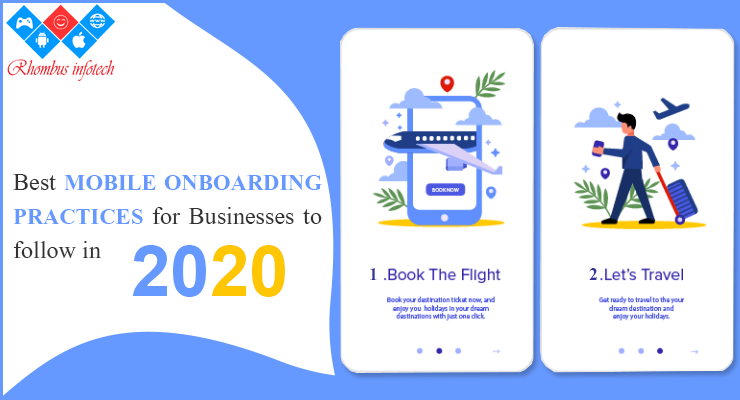Mobile app development starts and ends with the user. The difference between a successful mobile app and one that fails in the market is a quality user experience (UX). Without a thorough understanding of your target users’ in-app behavior patterns or psychological underpinnings, you won’t be able to build a mobile product to satisfy a central goal or exceed expectations.
App Onboarding is an efficient method used by organizations to enable users to comprehend your app and its functions. It is a walkthrough process or a tutorial that is meant to help users interact with the app and easily figure out what that particular app does and what they can achieve by continuing to use it.
Essentially, it is a series of screens that guide users through the app’s interface. Now, the onboarding screens typically have three purposes for which they are being used rigorously:
To enlighten the users about the utilitarian functions and benefits of the app.
To enable the users to register on the app via a login option.
It is aimed to gather useful profile data of the users, later used to offer personalized notifications and content.
Now that you understand the significance of app optimization, you will expect your mobile app development company to ensure that it follows the best practices. While there are some timeless ones that you need to adhere to, there are the progressive ones that come ahead with time. Here are the best practices for mobile app optimization that businesses should follow.
Highlight the value proposition of your mobile app
To start with, you need to understand that highlighting the best you have matters a lot when it comes to making the first impression. The on boarding process, therefore, should prioritize the value proposition of the app to entice the users to download, install, and use it. Start by explaining what your app offers and what the users will gain from it. Further, showcase the features and functionalities that they can leverage to accomplish the tasks they want to.
Compact the mobile app on boarding screens
An extended on boarding process can overwhelm the users, which may be the reason to abandon it or not even sign up in the first place. Whether you avail iOS or Android app development services, the developers will suggest avoiding text-heavy explanations and multiple screens as a part of the on boarding process. Stick to illustrations and app screenshots to send across the message. Adding tutorials and gamification in the screens is a good idea.
Have a short and simple app sign-up process
If you really want to maximize the number of downloads, ensure that the sign-up is simple and comprises minimal steps. This is something that the best mobile app developers will do in the first place. Rather than requiring the user to fill up expansive forms, you should provide the options of logging in with social accounts. It eliminates the friction from the on boarding process and boosts the number if downloads.
Ask for only mandatory information
Even while you provide social logins for sign up, you should request only for the information that is absolutely needed. As a rule of thumb, ask only for details that are relevant and crucial. It is noted that a major chunk of users does not install apps or uninstall the ones that require too much personal information. It is a human tendency to be irritated by excessive questions and suspect the ones that want details.
Request permissions explicitly
As there is genuine hype about user privacy, the on boarding process needs to pay extra heed to it. Additionally, asking the user’s permission for using their personal data and information is a part of business ethics. If your app needs to access the device camera or microphone, do ask for permissions at the time of on boarding itself. Asking for permissions sends across a positive message and wins the user’s trust as well.
Use progressive visual hints
Another app on boarding best practice you must stick to in 2020 is using progressive visual hints rather than hand-holding the users. Besides using the right visual, place them strategically at the points where the users are likely to get stuck and need help. This enables you to avoid tedious instructions while rendering ease and speed into the user experience.
Prioritize personalization
Every seasoned iOS and Android developer would prioritize personalization in the development and on boarding process. In fact, personalization alone can make an app stand apart in the competitive landscape. Spotify is the best instance of a personalized on boarding experience as it offers the users choices based on their genre, language, and preferred artists to give personalized content right from the start.
Give the choice to skip
Users are most likely to complete the process is they have alternatives that they may prefer. While some users may want to skip certain steps, others may like to skip the entire process. Giving them a chance to skip is another good practice that can have a more positive impression on the user experience your app offers.
Use cross-channel messaging
If you want to improve your app on boarding process, make sure that it delivers cross channel messaging. Push notifications are ideal to notify the users to complete the on boarding procedure if they have left it halfway. Emails and in-app messages are other channels where you need to be available to provide gentle reminders to the users.
Test before implementation
Finally, do not forget to test the on boarding process before implementing it. The on boarding experiences is as important as the app’s user experience itself. Therefore, it becomes crucial to test and assess the on boarding flow on different screens for ensuring that the transition to each screen size is smooth and seamless.

